Fiber Lasers
Definition: lasers with a doped fiber as gain medium, or (sometimes) just lasers where most of the laser resonator is made of fibers
More general term: solid-state lasers
German: Faserlaser
Categories: fiber optics and waveguides, lasers
How to cite the article; suggest additional literature
Author: Dr. Rüdiger Paschotta
(British spelling: fibre lasers)
Fiber lasers are usually meant to be lasers with optical fibers as gain media, although some lasers with a semiconductor gain medium (a semiconductor optical amplifier) and a fiber resonator have also been called fiber lasers (or semiconductor fiber lasers). Also, devices containing some kind of laser (e.g., a fiber-coupled laser diodes) and a fiber amplifier are often called fiber lasers (or fiber laser systems).
In most cases, the gain medium is a fiber doped with rare earth ions such as erbium (Er3+), neodymium (Nd3+), ytterbium (Yb3+), thulium (Tm3+), or praseodymium (Pr3+), and one or several fiber-coupled laser diodes are used for pumping. Therefore, most fiber lasers are diode-pumped lasers. Although the gain media fiber lasers are similar to those of solid-state bulk lasers, the waveguiding effect and the small effective mode area usually lead to substantially different properties of the lasers. For example, they often operate with much higher laser gain and resonator losses. See also the article on fiber lasers versus bulk lasers.
Fiber Laser Resonators
In order to form a laser resonator with fibers, one either needs some kind of reflector (mirror) to form a linear resonator, or one builds a fiber ring laser. Various types of mirrors are used in linear fiber laser resonators:
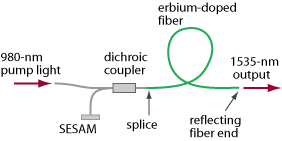
- In simple laboratory setups, ordinary dielectric mirrors can be butted to the perpendicularly cleaved fiber ends, as shown in Figure 5. This approach, however, is not very practical for mass fabrication and not very durable either.
- The Fresnel reflection from a bare fiber end face is often sufficient for the output coupler of a fiber laser. Figure 1 shows an example.
- It is also possible to deposit dielectric coatings directly on fiber ends, usually with some evaporation method. Such coatings can be used to realize reflectivities in a wide range.
- For commercial products, it is common to use fiber Bragg gratings, made either directly in the doped fiber, or in an undoped fiber which is spliced to the active fiber. Figure 2 shows a distributed Bragg reflector laser (DBR laser) with two fiber gratings, but there are also distributed feedback lasers with a single grating in doped fiber, with a phase shift in the middle.


- A better power-handling capability is achieved by collimating the light exiting the fiber with a lens and reflecting it back with a dielectric mirror (Figure 3). The intensities on the mirror are then greatly reduced due to the much larger beam area. However, slight misalignment can cause substantial reflection losses, and the additional Fresnel reflection at the fiber end can introduce filter effects and the like. The latter effects can be suppressed by using angle-cleaved fiber ends, which however introduce polarization-dependent losses.

- Another option is to form a fiber loop mirror (Figure 4), based on a fiber coupler (e.g. with 50:50 splitting ratio) and some piece of passive fiber.
Most fiber lasers are pumped with one or several fiber-coupled diode lasers. The pump light may be coupled directly into the core, or in high-power into a larger pump cladding (→ double-clad fibers), as discussed below in more detail.
There are many different kinds of fiber lasers, some of which are discussed in the following.

High-power Fiber Lasers
Whereas the first fiber lasers could deliver only a few milliwatts of output power, there are now high-power fiber lasers with output powers of hundreds of watts, sometimes even several kilowatts from a single fiber. This potential arises from a high surface-to-volume ratio (avoiding excessive heating) and the guiding effect, which avoids thermo-optical problems even under conditions of significant heating.
Nowadays, high-power fiber lasers are widely used e.g. in laser material processing. Examples for processes are laser welding and laser cutting e.g. on metals, but also with many other industrial materials. Many applications use a fiber laser machine with continuous-wave operation; limitations concerning pulse generation e.g. with Q switching are substantial, so that bulk lasers reach clearly superior performance in such domains.
See the article on high-power fiber lasers and amplifiers for more details.
Upconversion Fiber Lasers
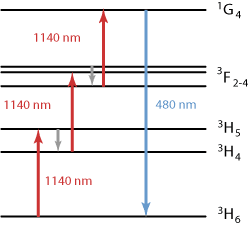
The fiber laser concept is most suitable for the realization of upconversion lasers, as these often have to operate on relatively “difficult” laser transitions, requiring high pump intensities. In a fiber laser, such high pump intensities can be easily maintained over a long length, so that the gain efficiency achievable often makes it easy to operate even on low-gain transitions.
In most cases, silica glass is not suitable for upconversion fiber lasers, because the upconversion scheme requires relatively long lifetimes of intermediate electronic levels, and such lifetimes are often very small in silica fibers due to the relatively large phonon energy of silica glass (→ multi-phonon transitions). Therefore, one mostly uses certain heavy-metal fluoride fibers such as ZBLAN (a fluorozirconate) with low phonon energies.
The probably most popular upconversion fiber lasers are based on thulium-doped fibers for blue light generation (Figure 6), praseodymium-doped lasers (possibly with ytterbium codoping) for red, orange, green or blue output, and green erbium-doped lasers.
See the article on upconversion lasers for more details.
Narrow-linewidth Fiber Lasers
Fiber lasers can be constructed to operate on a single longitudinal mode (→ single-frequency lasers, single-mode operation) with a very narrow linewidth of a few kilohertz or even below 1 kHz. In order to achieve long-term stable single-frequency operation without excessive requirements concerning temperature stability, one usually has to keep the laser resonator relatively short (e.g. of the order of 5 cm), even though a longer resonator would in principle allow for even lower phase noise and a correspondingly smaller linewidth. The fiber ends have narrow-bandwidth fiber Bragg gratings (→ distributed Bragg reflector lasers, DBR fiber lasers), selecting a single resonator mode. Typical output powers are a few milliwatts to some tens of milliwatts, although single-frequency fiber lasers with up to roughly 1 W output power have also been demonstrated.
An extreme form is the distributed-feedback laser (DFB laser), where the whole laser resonator is contained in a fiber Bragg grating with a phase shift in the middle. Here, the resonator is fairly short, which can compromise the output power and linewidth, but single-frequency operation is very stable.
Of course, further amplification to much higher power levels in a fiber amplifier is possible.
Q-switched Fiber Lasers

With various methods of active or passive Q switching, fiber lasers can be used for generating pulses with durations which are typically between tens and hundreds of nanoseconds (see e.g. Fig. 7). The pulse energy achievable with large mode area fibers can be several millijoules, in extreme cases tens of millijoules, and is essentially limited by the saturation energy (even for large mode area fibers) and by the damage threshold (the latter particularly for shorter pulses). All-fiber setups (not containing any free-space optics) are quite limited in terms of the achievable pulse energy, as they can normally not be realized with large mode area fibers and effective Q switches.
Due to the high laser gain, the details of Q switching a fiber laser are often qualitatively different from those of a bulk laser, and more complicated. One often obtains a temporal sub-structure with multiple sharp spikes, and there is a possibility of producing Q-switched pulses with a duration well below the (typically long) resonator round-trip time.
Mode-locked Fiber Lasers
More sophisticated resonator setups are used particularly for mode-locked fiber lasers (ultrafast fiber lasers), generating picosecond or femtosecond pulses. Here, the laser resonator may contain an active modulator or some kind of saturable absorber. An artificial saturable absorber can be constructed using the effect of nonlinear polarization rotation, or a nonlinear fiber loop mirror. A nonlinear loop mirror is used e.g. in a “figure-of-eight laser”, as shown in Figure 8, where there is a main resonator on the left-hand side and a nonlinear fiber loop, which does the amplification, shaping and stabilization of a circulating ultrashort pulse. Particularly for harmonic mode locking, additional means may be used, such as subcavities acting as optical filters.
For more details on ultrafast fiber lasers, see the article on mode-locked fiber lasers.
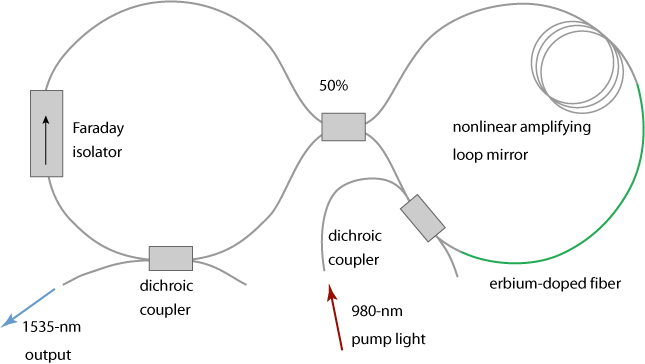
Raman Fiber Lasers
A special type of fiber lasers are fiber Raman lasers, relying on Raman gain associated with the fiber nonlinearity. Such lasers usually use relatively long fibers, sometimes of a type with increased nonlinearity, and typical pump powers of the order of 1 W. With several nested pairs of fiber Bragg gratings, the Raman conversion can be done in several steps, bridging hundreds of nanometers between the pump and output wavelength. Raman fiber lasers can e.g. be pumped in the 1-μm region and generate 1.4-μm light as required for pumping 1.5-μm erbium-doped fiber amplifiers.
Fiber Lasers with Semiconductor Optical Amplifiers
There are some lasers which have a semiconductor optical amplifier (SOA) as the gain medium in a resonator made of fibers. Even though the actual laser process does not occur in a fiber, such fibers are sometimes called fiber lasers. They typically emit relatively small optical powers of a few milliwatts or even less. Sometimes they exploit the very different properties of the semiconductor gain medium, as compared with a rare-earth-doped fiber, in particular the much smaller saturation energy and upper-state lifetime. Rather than only generating coherent light, such lasers can be used for information processing in optical fiber communications systems – for example the wavelength conversion of data channels based on cross-saturation effects.
Special Attractions of Fibers as Laser Gain Media
- As fibers can be coiled and the light propagating in fibers is well shielded from the environment (e.g. concerning dust), fiber lasers can have a compact and rugged setup, provided that the whole laser resonator is built only with fiber components (all-fiber setup) such as fiber Bragg gratings and fiber couplers (i.e., avoiding free-space optics and any requirement for alignment).
- Fiber gain media have a large gain bandwidth due to strongly broadened laser transitions in glasses, permitting wide wavelength tuning ranges and/or the generation of ultrashort pulses. Also, fiber lasers have broad spectral regions with good pump absorption, making the exact pump wavelength uncritical, so that temperature stabilization of the pump diodes is usually not necessary.
- Diffraction-limited beam quality is easily obtained when single-mode fibers are used, and sometimes also with slightly multimode fibers.
- Due to the high gain efficiency of doped fibers, fiber lasers have the potential to operate with very small pump powers. Also, it is possible to obtain very high power efficiencies.
- In recent years, the potential for very high output powers (several kilowatts with double-clad fibers) has been convincingly demonstrated (see above).
- Again due to the guidance, which allows high pump intensities to be applied over long lengths, fiber lasers can be operated even on very “difficult” laser transitions (e.g. of upconversion lasers).
On the other hand, fiber lasers can suffer from various problems:
- When the pump light has to be launched from free space into a single-mode core, the alignment is critical. This problem can be eliminated by using fiber-coupled pump diodes.
- Most fibers exhibit a complicated temperature-dependent polarization evolution, unless polarization-maintaining fibers or Faraday rotators are used. Such measures, however, are normally not compatible with nonlinear polarization rotation mode locking.
- Nonlinear effects often limit the performance, e.g. in terms of powers achievable in single-frequency operation or the pulse quality of mode-locked lasers. For example, Kelly sidebands are often seen, whereas mode-locked bulk lasers rarely exhibit this effect.
- At high powers, there is a risk of fiber damage even below the actual damage threshold of the material (→ fiber fuse).
- Fibers have a limited gain and pump absorption per unit length, making it difficult to realize very short resonators e.g. for single-frequency lasers or for multi-gigahertz mode-locked lasers. However, significant progress has been made in this direction recently via the development of very highly doped fibers, usually made from phosphate glasses.
Also note that fiber lasers are in many cases substantially more difficult to design than bulk lasers. This results from very different reasons, including strong saturation effects caused by the high optical intensities, the quasi-three-level behavior of nearly all fiber laser transitions, and the complicated pulse formation mechanisms in mode-locked fiber lasers. As a result, the laser development project can be more costly.
The article on fiber lasers versus bulk lasers compares the strengths and weaknesses of fiber and bulk lasers. See also the article on power scaling of lasers, containing thoughts on high-power fiber devices.
Fiber Laser Modeling
Many technical aspects in fiber lasers are significantly more complicated than in bulk lasers. Reasons for that are manifold:
- Fiber lasers are typically operated with a higher gain and higher resonator losses.
- Optical intensities in fiber lasers are often far above the saturation intensity, leading to strong saturation effects (even for pump waves).
- Most active fibers have quasi-three-level gain systems, and their operation characteristics are more complicated than those of four-level lasers.
- Fiber laser systems are often more complex, for example using master oscillator power amplifier architectures.
For these reasons, the operation details of a fiber laser (or fiber laser system) can often not be understood only based on simple analytical calculations. Numerical simulations, carried out with some kind of fiber simulation software, are therefore required for calculating the possible laser performance, analyzing detrimental effects, and optimizing prototype and product designs. Such simulations can address many different technical aspects:
- Rate equation modeling can be used for calculating the behavior of single laser-active ions, or combinations of ions involving energy transfer processes.
- A mode solver, i.e., a calculator for fiber modes, can produce inputs for further calculations – in particular, mode intensity profiles.
- In some situations, numerical beam propagation is of interest. For example, this is often the case for highly multimode fibers, including the pump claddings of double-clad fibers.
- Refined algorithms are required for calculating the steady state of lasers and amplifiers, with a self-consistent solution for optical intensities and excitation densities of laser-active ions throughout the fiber. (Note that optical intensities and excitation densities mutually influence each other.)
- Dynamical models are used for calculating pulse amplification and Q switching, for example.
- Ultrashort pulse propagation in fibers can also be numerically simulated under the influence of effects like laser gain, the limited gain bandwidth, chromatic dispersion, various nonlinearities, etc.
As an example for surprising features even of simple fiber lasers, Figure 9 shows the optical powers and excitation densities along the fiber of an Yb-doped single-mode fiber laser. A fiber Bragg grating with 25% peak reflectance at 1030 nm on the right side serves as the output coupler, whereas a highly reflecting Bragg grating is used on the left side. The pump light (at 975 nm) is coupled in through that grating. A nearly linear (rather than exponential) decay of pump power on the left side results from strong pump saturation. The fiber is somewhat over-long, resulting in slight signal reabsorption on the right side. That reabsorption maintains a significant ytterbium excitation despite the vanishing pump power, but causes only a negligible reduction in signal output power. Losses via ASE (not shown here) are also negligible.
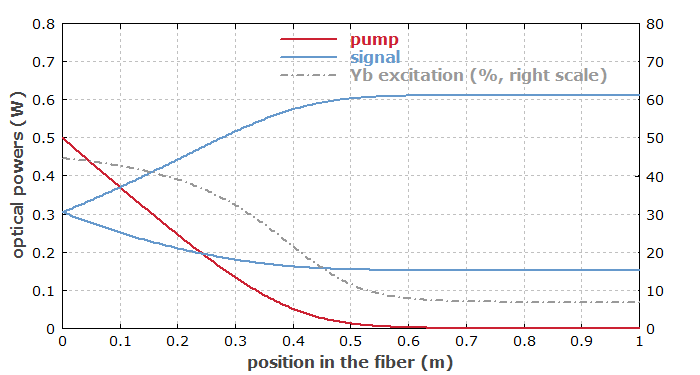
Figure 10 shows the same for a modified output coupler grating, so that lasing occurs at 1080 nm. The lower emission cross-sections at 1080 nm lead to a higher degree of Yb excitation and thus to weaker pump absorption. This demonstrates that the required fiber length depends not only on the absorption characteristics at the pump wavelength, but also on the details for the signal, such as the signal wavelength and the resonator losses.
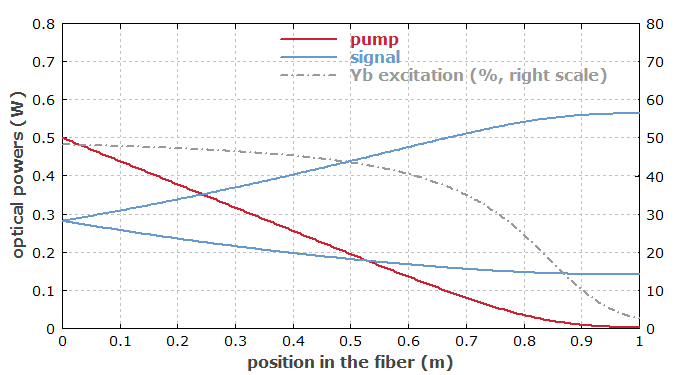
If the fiber length in the last case would be reduced to 0.7 m, one might expect a moderate reduction in output power due to incomplete pump absorption. However, a simulation (not shown here) tells that lasing would stop completely, and 94% of the pump power would leave the fiber on the right side. The Yb excitation density of about 50% throughout the fiber would not be sufficient to reach the laser threshold. For a reduced pump wavelength of 940 nm, however, lasing would be possible again – despite the reduced pump absorption cross section, because pump saturation effects would be weaker.
Suppliers
The RP Photonics Buyer's Guide contains 113 suppliers for fiber lasers. Among them:

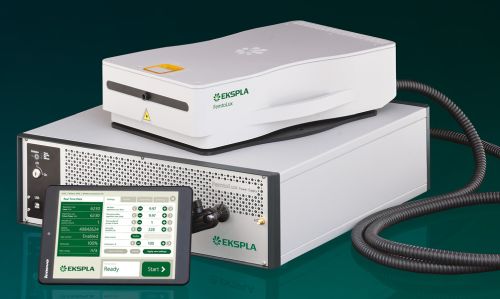
EKSPLA
FemtoLux 3 is a modern femtosecond fiber laser aimed for both R&D use and industrial integration. Tunable pulse duration in a range of 300 fs – 5 ps, adjustable pulse repetition rate up to 5 MHz and adjustable pulse energy up to 3 μJ allows optimization of laser parameters for the desired application. These include marking and volume structuring of transparent materials, photopolymerization, biological imaging, nonlinear microscopy and many others. To expand the scope of applications even further this laser can be equipped with a second harmonics module.
With the burst mode enabled, the FemtoLux 3 can generate bursts of pulses with energy above 10 μJ with instant burst shape control, which can significantly improve the efficiency of some processes.
Having a rigid, compact, passive air-cooled laser head and the possibility to control the laser from a wireless tablet, FemtoLux 3 can be integrated with different equipment, be it laser equipment for material micro-processing, microscopy or any other research equipment.

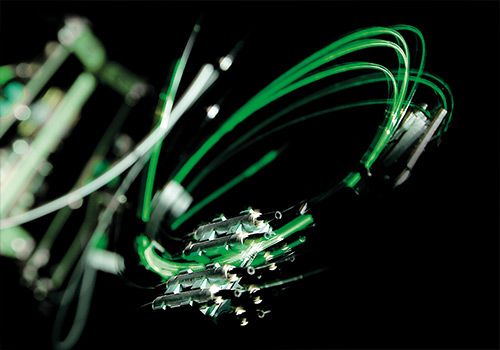
TOPTICA Photonics
The key for successful integration of ultrafast technology are robust, cost-effective systems with simple push-button operation. TOPTICA offers several products fulfilling these requirements: ultrafast fiber lasers based on erbium (Er) and ytterbium (Yb) like the FemtoFiber smart, FemtoFiber pro, FemtoFiber ultra and FemtoFiber dichro series. All these systems are based on TOPTICA FemtoFiber technology.
TOPTICA’s FemtoFiber lasers provide reliable femtosecond / picoseconds pulses based on polarization-maintaining fibers and SAM mode-locking. Different models (1560/780 nm, VIS/NIR tunable output, IR/NIR supercontinuum, short-pulse) cover a wide range of applications, e.g. nonlinear microscopy, two-photon polymerization, time-domain THz and attoscience.


IPG Photonics
High Peak Power delivers an all new QCW mode to CW lasers, available exclusively from IPG in the latest releases of YLR and YLS lasers. High Peak Power is made possible by IPGs QCW diode designs, which have the ability to provide very high peak power for short duty cycles, with real-time capability of switching to CW mode.
- faster & cleaner piercing
- increased quality
- repeatability
- less waste


RPMC Lasers
Fiber Lasers are inherently extremely stable, robust, and offer good beam quality. RPMC Lasers offer a wide range of fiber lasers including femtosecond, picosecond, nanosecond, and CW versions. The wavelengths on our fiber lasers range from 515 nm to 1950 nm.


NKT Photonics
The Koheras narrow linewidth, single-frequency fiber lasers are ultra-low noise sources with longitudinal single mode and single frequency operation. The lasers are based on a DFB design ensuring robust and reliable operation and are delivered as fully integrated systems for industrial and scientific applications. Koheras offers an unprecedented low phase- and intensity noise level at Yb, Er and Tm wavelengths. It has a very high stability, and mode-hop free inherent single frequency output – even when exposed to changing environmental conditions. You can also get shot noise limited solutions for applications demanding an extra low intensity noise level.


Menlo Systems
Menlo Systems' femtosecond fiber lasers based on Menlo figure 9® patented laser technology are unique in regard to user-friendliness and robustness. We offer solutions for scientific research as well as laser models engineered for OEM integration. From the shortest pulses to highest average power beyond 10 Watts and pulse energy beyond 10 μJ, we have the solution for your application ranging from basic research to industrial applications in spectroscopy, quality control, and material processing.


Lumibird
Lumibird manufactures an extensive range of mature and custom-designed optical fiber amplifiers and fiber lasers. High output powers are achieved through the use of double cladding fibers pumped by broad stripe diodes. Several varieties of pumping techniques are used each optimized for specific applications. Lumibird also develops key components for producing unique and innovative light sources.
Questions and Comments from Users
Here you can submit questions and comments. As far as they get accepted by the author, they will appear above this paragraph together with the author’s answer. The author will decide on acceptance based on certain criteria. Essentially, the issue must be of sufficiently broad interest.
Please do not enter personal data here; we would otherwise delete it soon. (See also our privacy declaration.) If you wish to receive personal feedback or consultancy from the author, please contact him e.g. via e-mail.
By submitting the information, you give your consent to the potential publication of your inputs on our website according to our rules. (If you later retract your consent, we will delete those inputs.) As your inputs are first reviewed by the author, they may be published with some delay.
Bibliography
| [1] | E. Snitzer, “Proposed fiber cavities for optical masers”, J. Appl. Phys. 32 (1), 36 (1961), doi:10.1063/1.1735955 |
| [2] | E. Snitzer, “Optical maser action in Nd3+ in a Barium crown glass”, Phys. Rev. Lett. 7 (12), 444 (1961), doi:10.1103/PhysRevLett.7.444 |
| [3] | C. J. Koester and E. Snitzer, “Amplification in a fiber laser”, Appl. Opt. 3 (10), 1182 (1964), doi:10.1364/AO.3.001182 |
| [4] | C. A. Burrus and J. Stone, “Nd3+ doped SiO2 lasers in an end-pumped fiber geometry”, Appl. Phys. Lett. 23 (7), 388 (1973), doi:10.1063/1.1654929 |
| [5] | J. Stone and C. A. Burrus, “Neodymium-doped fiber lasers: room temperature CW operation with an injection laser pump”, Appl. Opt. 13 (6), 1256 (1974), doi:10.1364/AO.13.001256 |
| [6] | R. J.Mears, L. Reekie, S. B. Poole, and D. N. Payne, “Neodymium-doped silica single-mode fibre lasers”, Electron. Lett. 21 (17), 738 (1985), doi:10.1049/el:19850521 |
| [7] | L. Reekie et al., “Diode-laser-pumped Nd3+-doped fibre laser operating at 938 nm”, Electron. Lett. 23, 884 (1987), doi:10.1049/el:19870625 |
| [8] | W. L. Barnes et al., “Er3+-Yb3+ and Er3+ doped fiber lasers”, IEEE J. Lightwave Technol. 7 (10), 1461 (1989), doi:10.1109/50.39081 |
| [9] | D. C. Hanna et al., “A 1-watt thulium-doped cw fibre laser operating at 2 μm”, Opt. Commun. 80, 52 (1990), doi:10.1016/0030-4018(90)90505-N |
| [10] | A. C. Tropper et al., “Thulium-doped silica fiber lasers”, Proc. SPIE 1373, 152 (1991), doi:10.1117/12.24937 |
| [11] | R. B. Smart et al., “CW room temperature upconversion lasing at blue, green and red wavelengths in infrared-pumped Pr3+-doped fluoride fibre”, Electron. Lett. 27 (14), 1307 (1991), doi:10.1049/el:19910817 |
| [12] | H. M. Pask et al., “Ytterbium-doped silica fiber lasers: versatile sources for the 1–1.2 μm region”, JSTQE 1 (1), 2 (1995), doi:10.1109/2944.468377 |
| [13] | P. Xie and T. R. Gosnell, “Room-temperature upconversion fiber laser tunable in the red, orange, green, and blue spectral regions”, Opt. Lett. 20 (9), 1014 (1995), doi:10.1364/OL.20.001014 |
| [14] | R. Paschotta et al., “230 mW of blue light from a Tm-doped upconversion fibre laser”, JSTQE 3 (4), 1100 (1997), doi:10.1109/2944.649548 |
| [15] | Y. Takushima et al., “Polarization-stable and single-frequency fiber lasers”, J. Lightwave Technol. 16 (4), 661 (1998), doi:10.1109/50.664080 |
| [16] | V. Dominic et al., “110 W fibre laser”, Electron. Lett. 35, 1158 (1999), doi:10.1049/el:19990792 |
| [17] | S. D. Jackson et al., “Diode-pumped 1.7 W erbium 3-μm fiber laser”, Opt. Lett. 24 (16), 1133 (1999), doi:10.1364/OL.24.001133 |
| [18] | M. Pollnau and S. D. Jackson, “Erbium 3-μm fiber lasers”, JSTQE 7 (1), 30 (2001), doi:10.1109/2944.924006 |
| [19] | Y. Jeong et al., “Ytterbium-doped large-core fiber laser with 1.36 kW continuous-wave output power”, Opt. Express 12 (25), 6088 (2004), doi:10.1364/OPEX.12.006088 |
| [20] | A. Polynkin et al., “Single-frequency fiber ring laser with 1 W output power at 1.5 μm”, Opt. Express 13 (8), 3179 (2005), doi:10.1364/OPEX.13.003179 |
| [21] | A. Tünnermann et al., “Fiber lasers and amplifiers: an ultrafast performance evolution”, Appl. Opt. 49 (25), F71 (2010), doi:10.1364/AO.49.000F71 |
| [22] | S. Fu et al., “Review of recent progress on single-frequency fiber lasers”, J. Opt. Soc. Am. B 34 (3), A49 (2017), doi:10.1364/JOSAB.34.000A49 |
| [23] | M. J. F. Digonnet, Rare-Earth-Doped Fiber Lasers and Amplifiers, 2nd edn., CRC Press, Boca Raton, FL (2001) |
| [24] | R. Paschotta, tutorial on "Modeling of Fiber Amplifiers and Lasers" |
| [25] | R. Paschotta, Field Guide to Optical Fiber Technology, SPIE Press, Bellingham, WA (2010) |
See also: fibers, rare-earth-doped fibers, double-clad fibers, fiber amplifiers, high-power fiber lasers and amplifiers, distributed feedback lasers, fiber lasers versus bulk lasers, power scaling of lasers, fiber simulation software, Raman lasers, The Photonics Spotlight 2011-02-10
and other articles in the categories fiber optics and waveguides, lasers

This encyclopedia is authored by Dr. Rüdiger Paschotta, the founder and executive of RP Photonics Consulting GmbH. How about a tailored training course from this distinguished expert at your location? Contact RP Photonics to find out how his technical consulting services (e.g. product designs, problem solving, independent evaluations, training) and software could become very valuable for your business!
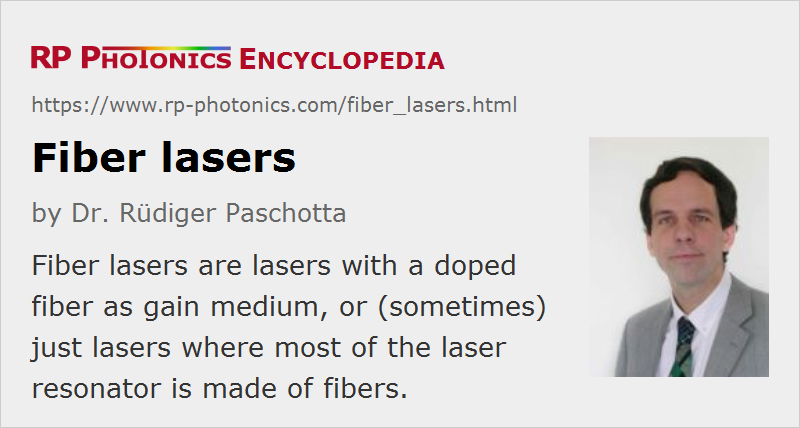 |







2020-05-05
For my fiber ring laser with any gain medium like Yb, Er, Th, as the gain fiber length decreases the center emission shifts to shorter wavelengths at steady state condition. Why is it so? The ring laser doesn't have any wavelength filter like an FBG or other bandpass filter.
Answer from the author:
This is a typical behavior for quasi-three-level gain media. The longer the fiber, the more the gain maximum shifts to longer wavelengths, because reabsorption of laser radiation at shorter wavelengths becomes more important.